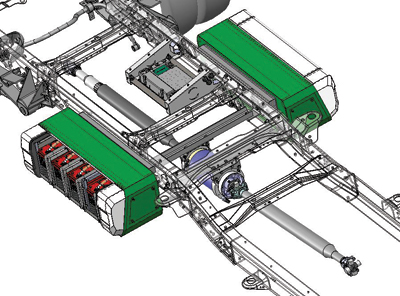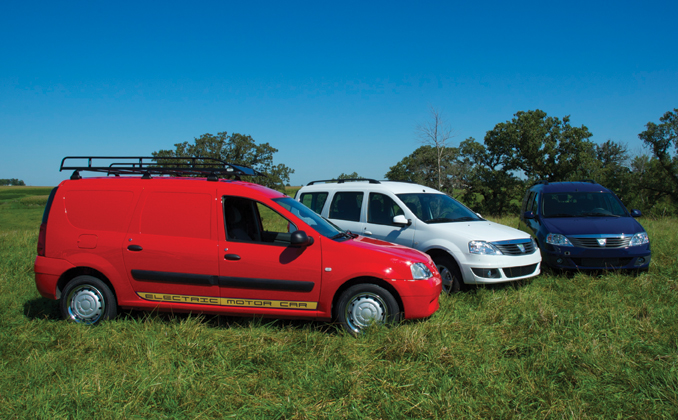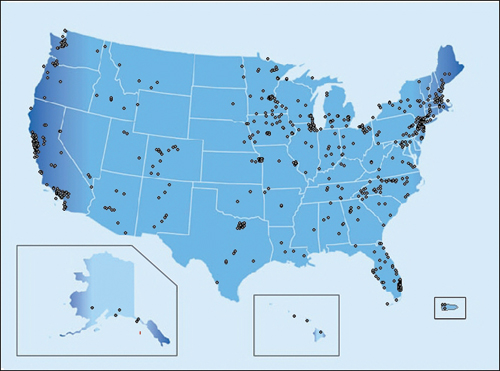Americans bought more than 16 million vehicles a year before the recent recession plunged sales to a pace of fewer than 10 million. But a continued rise in oil prices could send demand for electric vehicles (EVs) climbing much faster than expected. And strategies for accelerating the introduction of EVs could drive those numbers significantly higher still. Pike Research1 predicts that automobile dealerships in the United States will sell 650,000 electric vehicles a year by 2015. The question is, how can energy providers control the rollout of EVs in their service areas through deliberately planned policies – rather than a roll of the dice?
A growing number of utilities are making plans to do just that through incentives on charging, setting controlled public charging stations and even increasing revenues with “buy to lease” and Electro-commerce programs. Utilities are now setting incentives to encourage off-peak charging of EVs. Utilities may also be granted the ability by state utility commissions to buy large numbers of electric cars, light trucks and even local delivery trucks and service vehicles and lease them to their customers thus increasing company’s revenues.
Costs and Employing a New Metric- Miles Per Gallon CARbon Release Equivalent
The major stumbling block standing in the way of the EV revolution is the need for an easy way to explain the benefits to a buying public. The industry needs a new metric in discussing relative carbon release and operating costs. Already, there have been accusations that electric vehicles, powered by grid energy, released about as much carbon as high efficiency gas-powered cars or hybrids. Yet this claim ignores the fact that not all grid energy is generated by carbon-release sources.
We need to carefully articulate what the capabilities and limitations are with electric transportation.- Utilities want to provide customers with lower cost transportation options, but those options have to be reliable and the customers have to be able to make accurate comparisons between the cost and carbon release data for both electricity and gas-powered vehicles.
The electric car industry is already setting new terminology for energy use and carbon release. A new computer program called Miles Per Gallon -CARbon Release Equivalent (MPG/CRE) is being released in June of 2011 (sidebar). The program puts gasoline and electricity powered vehicles on a level playing field as to what their operation costs and carbon release are expected, based on actual energy generation sources.
Turning Challenges into Control and Opportunity
Utilities often express concern that EVs placed in clusters might put too much demand on the energy delivery system. The “nightmare scenario” is described as a hot summer afternoon when a cluster of EV owners coming home for a few critical hours each day to their neighborhood, turn on their air conditioners, microwaves, plasma screen TVs, and plugging in their electric cars all at the same time.
“We’re talking about doubling the load of a conventional home,” says Karl Rabago, who leads Austin Energy’s EV-readiness program.”
“It’s big. The electric transportation opportunity is a classic ‘systems’ issue, involving traditional utility concerns of reliability, safety, security, and fair allocation of infrastructure costs. It also requires developing a clear view on new services, customer preferences and product development synergies.”
“That’s our part; from the customer’s side it’s as simple as plugging your car into a wall!” says Rabago.
Yet a number of ideas are emerging that allows the energy provider to control the impact of EV introduction in their service area. Dominion Energy in Northern Virginia has proposed a special rate for EV charging that would translate into fuel costs of less than a penny a mile as compared to nearly 15 cents per mile for cars operating on $4 per gallon gasoline.
“Based on sales of hybrid cars, we believe many of our customers will purchase EVs and they will recharge them at home. We need to be ready,” said Kenneth D. Barker, vice president of Customer Solutions and Energy Efficiency. Dominion supports federal initiatives to lessen our nation’s use of petroleum and Governor Bob McDonnell’s energy plan to improve the energy efficiency of vehicles in the state and utilization of alternate fuels.
“Electric vehicles have the potential to affect the company’s infrastructure at all levels – transmission, distribution and generation. This pilot program enables the company to gauge potential impacts from electric vehicles. The pilot offers customers rate options structured with pricing levels to encourage charging outside of the peak demand periods of the day,” Barker says.
Utilities joining Forces with Electric Vehicle Dealerships- Electric Vehicle as a Leasable Asset
Utilities are now developing ways to provide their customers what they want, controlling EV rollout and company increasing revenues. Electric car companies, led by the advertising budgets of Nissan and General Motors, are announcing the release of the new electric car revolution. Investor-owned utilities are always looking for ways to control their own destiny and generate new revenues by bringing new, high demand services to their electricity customers within the restrictions of the state utility board. It is usually a tricky balance.
With the economy still sluggish, there are few places in a family budget that are available for utilities to tap for more revenues. Yet the introduction of EVs that have fairly impressive range, 100 to 200 miles on a single charge, will provide opportunities to generate far more revenues for utilities than just the fees for using off-peak electricity for charging. Utilities will have the opportunity to gain access to the already set family budget items allocated for transportation, the monthly car payment, gasoline and service. That can add up to as much as $500 per customer per month but the real opportunity is when all revenues sources are calculated.
The Electric Vehicle As Asset (EVAA) Revenue Generation Tool was commissioned from faculty and graduate students from the University of Iowa Tippie College of Business (see sidebar). The EVAA Revenue Generation Tool was designed to assess gross revenue and profitability for a variety of purposes including an EV “bulk buy and lease” program.
The variables involved in the creation of the model include expansion of asset load as it relates to retained earnings if EVs are determined to be classified as assets, leasing fees for leasing EVs to utility customers in conjunction with a local automobile dealership, depreciation on equipment, carbon credits and green tags, increase in electricity usage and service fees on the equipment in conjunction with local automobile dealership.
This model would apply for regular cars but also for the retrofit hybrid conversion kits for class 3-8 service trucks and buses. This new technology runs as low as $25,000 per conversion for service vehicles to reduce fuel consumption by 70%.

New technologies to quickly and cost effectively retrofit a Class 3-8 service truck or bus
are coming into the market. This conversion takes just 8 hours and can reduce diesel fuel
consumption by as much as 50%.
Running the Number for the EVAA Model
Taking an example of the purchase of a single electric car which sells for $40,000, the EVAA Revenue Generation Tool* is able to calculate the following annual revenue sources and return on the utility investment:
EVAA Revenue Generation Tool
| Federal subsidy | ..... | $7,500 taken off the price of the vehicle |
| State subsidies may be factored in | ..... | $0-10,000 |
| Percentage of retained earnings on asset load expansion | ..... | $4,810 @ 12.7% asset-based retained earnings level |
| Leasing Fees | ..... | $2,250 (@7.5%) |
| Carbon credits or green tags sales | ..... | $1,000 at market value |
| Depreciation | ..... | $2,000 at a 5 year schedule |
| Service contract revenue sharing with automobile dealership | ..... | $500 |
| Increased electricity usage for charging vehicule | ..... | $500 |
*These figures are all estimates, but taking into consideration the state and federal subsidies and backing those funds out of the equation, the EVAA Revenue Generation Tool calculates that a utility can generate roughly $13,000 - $20,000+ of additional revenue on a net investment of $40,000. Modeling indicates that the return on investment would range from 33.5% to 50%.
There are automobile retailers networks that are preparing to reach out to utility companies around a buy and lease program for their long range, highway capable car and light truck and service vehicle conversion lines. Gabus Automotive Group (Des Moines, Iowa) is planning to set up 100 electric car/truck dealerships by the end of 2011. Many of these dealerships will be offering fleet sales of the electric cars and trucks to customers through utility companies.
“We sell over one half of a billion dollars of vehicles every year and we use a lot of electricity as well so we know a little about both industries.” says Gene Gabus, President of Gabus Automotive Group. Our network of dealerships are excited about supporting utilities as they look to provide their customers with a cost effective way to drive a new electric car and save around $150 per month over a gas-powered vehicle. Basically the saving pays for most of the lease payment. All this, plus the utility realizes a solid return on its investment, making this a real win-win situation.”

Some smaller auto-makers, such as Envision Motor Company, are rapidly bringing all-electric
vehicles to market by simply converting proven platforms. (Pictured: Envision Motor Company vehicles
with American-manufactured electric motor and robust battery delivering 150-200 miles per charge.)
A legal advisor for a Midwest utility board pointed out that the two questions to be answered are is the EVAA program beneficial for the rate payer who buys the EV and is the EVAA program beneficial for all rate payers associated with that regulated utility. The answer was provided by the Consumers Advocate Office in that same state – a solid “yes” to both questions. The customer leasing the EV gets as much as $2,000 less cost in transportation each year. The utility is able to realize solid returns for its investment and an ability to shift demand in a positive direction. The ratepayers who did not buy an EV should realize more stable rates as the utility received income from other sources than electricity rates.
Utilities Can Control the Rollout of Automobile and Service Vehicles in Their Service Areas
As the new reliable highway-capable EVs and Class 3-7 local service trucks/buses begin to appear on the market, investor-owned utilities are likely to become a major driving force in their introduction. The EVAA Revenue Generation Assessment Tool simply assists in setting the roadmap for the introduction. Utilities can better estimate their returns on investment and control where the vehicles are charged and when as they promote electric cars and trucks. The opportunities look very promising. The industry is already setting demonstration projects using the state of the art EVs and service truck conversions.
Roger Christianson, from the Omaha Public Power District, thinks that non-profit driven energy companies can also benefit from the EVAA program. “We need to influence our customers to help us shift the energy demand more evenly from peak to off-peak times of the day. The EVAA program gives the customer a huge financial benefit so that it probably would not be a big inconvenience if we put in as a condition of the lease the requirement that we be able to remotely turn on and off his EV charging station. We can do that remotely and that could, as the EV numbers grow, help us control the peak, off-peak balance of energy supply.”

Over a thousand U.S. communities have signed the Council of Mayors Agreement for Climate Change.
Utilities can help these cities meet their goal for reducing carbon release by 30% within 30 years.
Electro-commerce and Utility-controlled Public Charging Stations
The establishment of utility-controlled public charging stations, such as the network being developed in Austin, can have a much greater commerce potential than just realizing revenues from electricity sales. Spending money takes time. Mall owners can tell how much a buyer will spend if that buyer spends a certain amount of time in the mall. Businesses will want that buyer to spend time in their establishment while their EV is being charged.
Many businesses will want a charging station on-site and pay for the vehicle charge just to get the customer in the door. Motels, hotels, cinemas, restaurants, hair salons, grocery stores and almost any business that has something to sell will want the electric car owner to come and get a free or reduced rate charge. Electro-commerce will be a strong consideration of where the charging stations are located.

Utilities may soon work with local businesses and Google to help EV owners decide what route
to drive and what purchases will be made along that route. (Rendering courtesy of Heritage Industries.)
The MPG-CRE Metric: Evening the Playing Field with Gasoline
The war of words has been ongoing for some time between those who support electric transportation and those who think that the answer is making more efficient gasoline-powered vehicles. True, it is a matter of carbon release, but mostly it is a matter of operating expense. Supporters of oil-based transportation have already put forth the notion that electric vehicles can release as much carbon as a gasoline-powered one. They cite the fact that the electricity that is used to power that car comes from power plants that release carbon into the environment, so people who are thinking of buying an EV for the purpose of having their vehicle release less carbon in the environment are misguided.
A new computer program – planned for release in June of 2011 – will strive to put the electricity/gas carbon and expense discussion on an even playing field. The program will track miles traveled as well as how much electricity was used, the cost of that electricity, and even where the energy was generated. The opening discussion from the oil industry assumed that all electricity is produced from coal-fired power plants, which, of course, is not the case. In reality, nearly every utility has a growing component of renewable energy available in the mix that they offer customers.
The Miles Per Gallon-CARbon Release Equivalent (MPG-CRE) will be able to calculate the relative statistic for a given electric car in relation to the amount of carbon released by that car travelling a certain number of miles. It will translate the statistic to a metric that is well known in the gasoline-power vehicle industry: miles per gallon (mpg). Thus, a conventional gasoline car could be rated at 35 miles per hour; a hybrid could be rated at 50 miles per hour; and an all-electric vehicle might be rated at 125 miles “per hour-CARbon Release Equivalent”. However, for an EV that is powered by an energy supply that has a wind or solar panel offset program, that car could experience up to a 270 MPG-CRE.
This new metric can provide an indication of the relative release of carbon and can also track the relative operating expenses. For example, Dominion Energy is requesting a new rate for off-peak electric vehicle charging that could see the energy costs of transportation settle in at around 0.7 cents per miles as compared to nearly 15 cents per miles with $4 per gallon gasoline. Electric car service departments want to use the program to track performance and indicators of how the vehicles are performing so that maintenance appointments can be set based on the data, reported via the Internet.
Discussions are underway to have the charging station serve as information centers and Electro-commerce navigation stations. With MapQuest, Google and Garmin already setting the stage, Intelligent Charging Stations could be asked to plot a “trip map” that includes stopping by the dry cleaners, buying some groceries, picking up the kids at school and ordering Chinese take-out for supper.
With cities already supplying charging station locations to the Internet map companies, hotels, motels, cinemas and restaurants will be able to communicate with the charging station and with the consenting EV owner. All of these communications have revenue potential back to the utility that owns that charging station through Electro-commerce programs.
Conclusion
“Electric vehicles are making consumers think in a new way – about the economic, environmental, and lifestyle impacts of gasoline versus electric fuel – and utilities and automakers share the education responsibilities of our shared customer,” says Steve Powell, the Manager for the Southern California Edison’s Program for Plug-in Vehicle Readiness.
“In addition to customer outreach, utilities have an important role to play, starting by making sure that we can provide smooth customer service and our grids can accommodate these new vehicles. At this nascent stage, Southern California Edison is also offering time-of-use rates that help customers manage the cost of fueling and encourage off-peak charging.”
Electric vehicles are most certainly going to play a role in the transportation scenario for the future. Electric utilities can shape that future with innovative strategies that integrate these vehicles into their energy supply network. The utility can have much greater control of the electric vehicle roll-out by exploring and implementing such innovative programs as charging time and location incentives, Electric Vehicle as Asset program involving local auto dealerships can establish Electro-commerce programs with local and regional businesses. Utilities are already deciding that they want to shape the electric vehicle landscape instead of responding to an uncertain future.
About the Authors

Michael Garvin is a former Technology Transfer Specialist for the University of Iowa, where he designed entrepreneurial studies courses and has developed seven start-up companies in the states of Iowa, Wisconsin and Texas. Garvin founded his current company, RENAIS (Renewable Energy Network for Aggregating and Integrating Services, LLC), in 2009 to set economic models that allow electric and plug-in hybrid vehicles to become viable commodities in the mainstream automotive market. He is one of the founding members of the Iowa Northern Energy Corridor (INEC), which pairs the most advanced non-oil energy production technologies in the context of a major short-haul railroad corridor stretching from Cedar Rapids, through Waterloo to Manly, Iowa. Garvin earned his BA from Benedictine College (Atchison, KS) and graduated with a MHA (Master of Hospital Administration) from St. Louis (MO) University in 1973. Before becoming an Iowa State University Project Director in 2008, Garvin served as a Program Development Specialist at the University of Texas-Houston (2002-2004) and at Texas A & M University (2003-2008).

Joe Sulentic has taught at the University of Iowa’s John Pappajohn Entrepreneurial Center since 1998 and started his first business while an undergraduate at UCLA. A USASBE nominee for Entrepreneurial Instructor of the Year in 2005, Sulentic’s approach to instruction includes real world sales activities to give students pragmatic lessons as would-be entrepreneurs. After receiving his undergraduate degree in economics, he spent two years in Italy as a Formula 3 racecar driver in Italy. Later, while completing his MBA, Sulentic worked for the USF&G Arrows Formula 1 racing team. He is currently working with Porsche Engineering of Weissach, Germany on the next generation of small-scale wind turbines for residential and commercial use. Sulentic holds a Bachelor of Arts in Economics (1984) from the University of California-Los Angeles and earned his Master of Business Administration degree from the University of Iowa (1987).
1 Pike Research is a market research and analysis firm and CleanTech forecaster based in Boulder, Colorado







